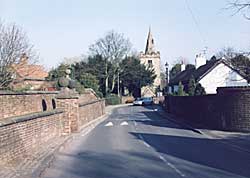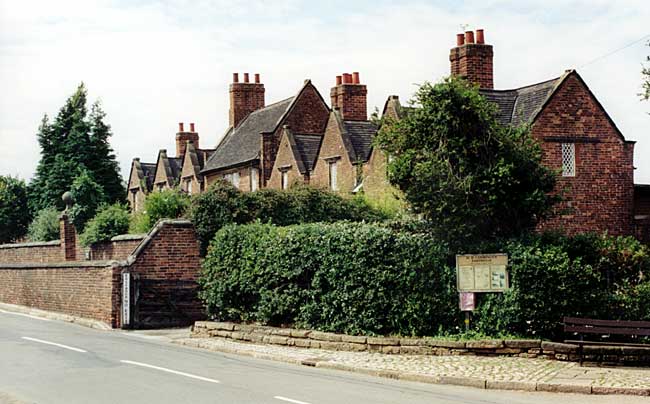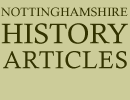Cossall
By Edwin Trueman and R Westland

St Catherine's church, Cossall, dates from the 13th and 14th centuries (photo: A Nicholson, 2004).
ABOUT six miles.W.N.W. from Nottingham, and one mile E. from Ilkeston, is the village of Cossall, along the outskirts of which flows the River Erewash, separating the counties of Derby and Nottingham. The lord of the manor is Lord Middleton. The village comprises 910a. 2r. 23p. of land, and had when the census was taken in 1871, 55 houses and 235 inhabitants. The Church, which is dedicated to St. Catherine, is a small, ancient edifice, probably built in the thirteenth century. It comprises chancel, nave, north and south aisles, and tower, with spire. It has two bells, which bear the date of 1733. In 1718 the fabric underwent considerable alteration; and in 1842 the whole edifice was rebuilt, with the exception of the spires by the Rev. Francis Hewgill. The east window is of stained glass, but does not represent any subject. In each of the two south windows of the chancel are two small circles of stained glass, which for richness of colour we have never seen excelled. One of these circles bears date 1310, and another 1584. The remaining two have simply the words, "Morteyne," and "Willoughby," respectively painted on a band with which each is surrounded. In one of the windows of the south aisle is a square of painted glass, which appears to be a very ancient piece of work. Within the Communion rails is a marble tomb, but it hears no inscription. The curacy is annexed to Wollaton.
Bailey, in his "Annals of Nottinghamshire," says:—
The manor of Cossall, alias Cossall Marsh, late belonging to the monastery of Newstead, and then in the occupation of Francis Willoughby, was on the 21st of July, 1568, granted to Percival Bowes and John Maysick, gentlemen. The monastery of Dale had a wood of fifteen acres in Shortwood, in this parish, which Queen Elizabeth granted to Sir Christopher Hutton, who became Lord High Chancellor of England. This property now belongs wholly to the noble house of Willoughby, of Wollaton. Cossall was, for many generations, the residence of a family who took their name from the place, though the lordship was shared by the family of Mortein, the original possessors, after the Conquest, of the lordship of Wollaton. Sir William do Cossall was a man of considerable note in his time, being by Edward III. elevated to the rank of a baron of the Exchequer. He was a great benefactor to the Abbey of Newstead, as is proved by the circumstance that at Trinity and Michaelmas terms, at York (8 Edward III.), he settled, by fine, upon the prior and canons of that house twelve messuages, one mill, eight bovats and sixty acres of arable land, twenty of meadow, and eighty of waste, and twenty shillings rent, with the appurtenances, in Cossall, Nottingham, and Bulwell, to find three chaplains—two in the Church of St. Catherine, at Cossall, and the third in the said priory at Newstead, to celebrate Divine service for the souls of the said William, his ancestors, and successors. The remainder of the lordship belonging to the Cossall family, which was not bestowed for religious purposes, was sold to Sir Richard de Willoughby, the elder, who had likewise assigned to him, by Sir Roger de Mortein (7 Edward II.), four score acres of wood in Wollaton, and the advowson of the churches of Wollaton and Cossall. William, the son of Sir Roger de Mortein (2 Edward III.), granted him likewise the whole manor of Wollaton, except the capital messuage. Sir Richard de Willoughby (son of the above Sir Richard) married the daughter of Sir Roger de Mortein, and had the village of Cossall as a marriage gift, which he afterwards gave to his son Richard, who married the sister of John de Grey, of Codnor, but died without issue.

Cossall village (photo: A Nicholson, 2004).
In 1722 Parliament passed a Bill compelling all Papists, refusing to take the oaths of supremacy, allegiance, and abjuration, to register their names, places of abode, and the situation of their real estates. Amongst those whose names were included in these registration returns was Robert Willoughby, Esq., of Cossall, county of Nottingham, who held lands of the annual value of £186 14s. 0d. It is probable that this Richard Willoughby resided at the manor house, now in the occupation of Mr. Godber, farmer. This house was in ancient times surrounded with a moat, which must have been crossed by means of a drawbridge. Traces of the moat are still visible.
In the parish chest are the accounts of the churchwardens and overseers for about fifty years, dating from 1717. They seem to have been well kept, and do not furnish so many entries of a curious character as might be expected in a country place. These, however, are a few specimens of the entries appearing therein:—
The registers of the Church date from 1650, but (as in many other places) do not appear to have been kept with much order until the present century. The number of marriages solemnised from Jan. 1, 1801, to the end of 1879, was 196. The burials during the same period numbered 502, or an average of six a-year. Out of those interred, only eight reached the age of ninety years. The following are their names and ages, with the dates of burial:—
| Aug. 7, 1814 — Alice Archer | .. 92 | |||||
| Feb. 5, 1825— William Wheatley | .. 93 | |||||
| Mar. 26, 1826— Michael Strey | .. 92 | |||||
| Nov. 8, 1843— Elizabeth Syson | .. 93 | |||||
| Aug. 1, 1856— Thomas Wheatley | .. 90 | |||||
| Jan. 31, 1861— Luke Wheatley. | .. 91 | |||||
| Jan. 1 , 1871— Rebecca Hooley | .. 93 | |||||
| Nov. 25, 1872— William Chambers | .. 93 | |||||
| 1718. | Pd. for ale when ye Arch Deacon came to | ||||
| view ye Church | £00 | 00 | 06 | ||
| 1722. | Pd. for ale on holy Thursday | 00 | 00 | 06 | |
| 1731. | For ringing at ye King's Coranation | 0 | 1 | 0 | |
| (Nov. 6) For ringing a verry fine peal | 0 | 1 | 0 | ||
| 1732. | Given to 2 men baborously used by the | ||||
| turkes | 00 | 00 | 04 | ||
| Given to a man with a leter of request who'd | |||||
| lost 600 pounds at sea | 00 | 01 | 00 | ||
| 1734. | Pd. to Robt. Haseldine for making the stocks | 00 | 07 | 06 | |
| 1736. | For going to Beeston Statutes | 00 | 01 | 06 | |
| Given to 3 Turkey slaves | 00 | 00 | 06 | ||
| Pd. for 2 shifts for Catherine Chambers | 00 | 05 | 06 | ||
| Given to 2 sailors with a Pass | 00 | 00 | 06 | ||
| 1737. | Gave 3 men for loss by fire | 00 | 01 | 06 | |
| 1739. | Pd. Hen. Johnson & Franc. Roe for a Fox. | 0 | 1 | 0 | |
| 1740. | Searching the Town and going to Ilkestone | ||||
| with hue and cry | 0 | 1 | 0 | ||
The following remarkable poetical effusion, under the heading of "The Rich Man's Dream," is written on the same leaf as are the accounts for 1776, but the name of the writer is not given:—
I dreamt as buried in my fellow clay.
Close by a common beggar's side I lay;
And so mean an object skock'd my pride—
Thus, like a corps of consequence, I cry'd.
Scoundrel, begone! and henceforth touch me not,
More maners learn, and at a distance rot !
How, scoundrel? with a haughtier tone, cried he:
Proud lump of earth, I scorn thy words and thee:
Here all are equal—now thy case is mine—
This is my rotting place, and that is thine.
Death only shews us the true sise of men,
Who when alive look big and swell; but when
That puff of breath is gone that hath so little room,
Shrinks from an empire to a narrow tomb.

The Willoughby Almshouses were built in 1685 and endowed by George Willoughby (photo: A Nicholson, 2004).
In 1685, George Willoughby, Esq., executed a deed, which recited that he had erected a hospital in Cossall, for four poor men and four poor women, which he conveyed to twelve trustees, to whom he also conveyed a farm at Roston, in the county of Derby, and two closes in Ilkeston, called the New Close (alias Fractimonty Close), and the Bywaterhole Close, in trust, that they should pay £5 half-yearly, for ever, to each of the eight poor people in the said hospital, for their maintenance; and every two years provide each of them with a grey cloth gown, at 3s. per yard. None of the poor men to be under 60, nor the poor women under 55, and all of them to be single persons, and liable to be turned out if they married or misbehaved themselves. And further, he directed 5s. to be paid yearly, to find coals for each house. In 1827 (at the time of the Commissioners' inquiry) the annual income of the charity amounted to £132. Now the income is still greater, so that the old men receive 7s. 6d. a week, and the women 6s. The former also receive coats, and the latter gowns, every two years. The annual sum allowed for the purchase of coal has likewise been largely augmented.
| 1744. | Pd. for a Press warnt. & 4 officers attending | |||
| the Justices, &c. | 0 | 8 | 0 | |
| Spent at Margt. Farnworth's, when we made | ||||
| search for men fitt for the King's service | 0 | 1 | 6 | |
| For sitting up with Betty Grace | 0 | 0 | 6 | |
| 1746. | A prayer Book and a paper of Destemper in | |||
| Cattell | 0 | 2 | 6 | |
| 1753. | Given to some sefaring people | 0 | 0 | 6 |
